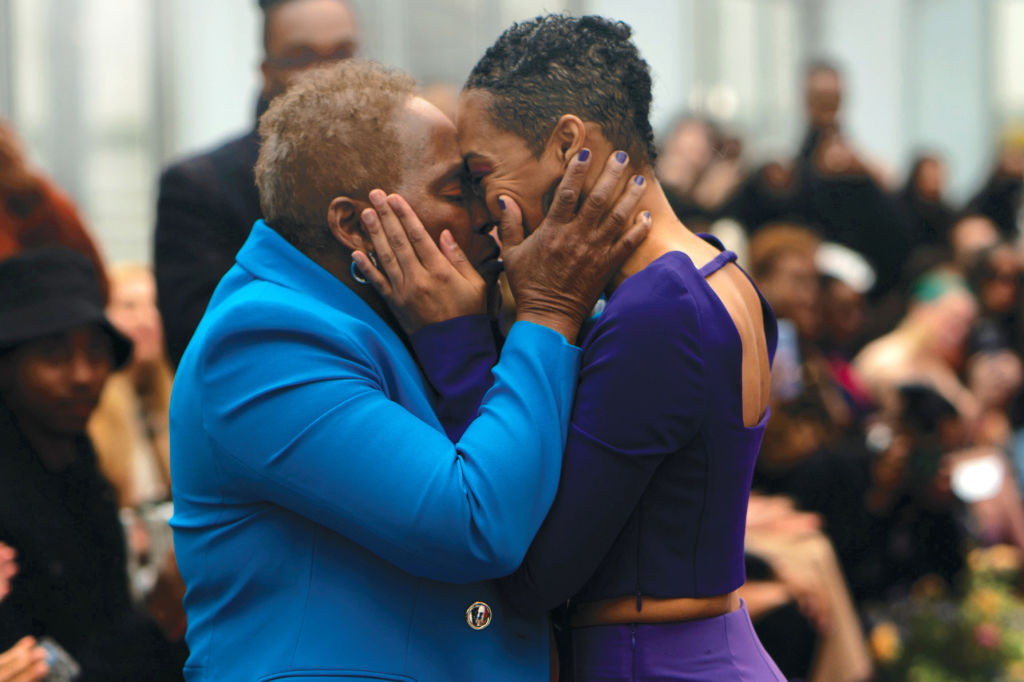Culture
 Cynthia + Najla Burt. Photo by Interstellar Studio.
Cynthia + Najla Burt. Photo by Interstellar Studio.
The Driving Force Behind Dur Doux
April 1, 2022 @ 9:00am
On a snowy Sunday in February, I ran down a city block in Manhattan in desperate search of The Overlook at Bryant Park for my first-ever New York Fashion Week show. When I finally made it to my destination, I was immediately enamored with the rich and bold tapestries of color in the room — and the buzz of excitement reverberating off the audience. While my frame of reference for Fashion Week hadn’t ventured far beyond an episode of “Sex and the City,” I could immediately tell I was about to witness something very unique in the fashion world.
I felt validated when Annie Lennox’s vocals came through the speakers, “Sweet Dreams” echoed through the vast space and the first transgender model to appear on “Project Runway,” Mimi Tao, glided down the purple runway in a neon orange tulle gown. Tao has become like family to Cynthia and Najla Burt, the mother-daughter team behind affordable luxury lifestyle brand Dur Doux.
“She sets the stage for the message we want to deliver about equality,” Cynthia says of Tao, who she notes is in almost every show she produces with her daughter Najla. “We, in every fiber of our being, believe in it. There is beauty in every single woman. It’s not just the clothes they wear. It’s them. It’s the persona they convey. That’s what we want for every woman.”
The “Project Runway” star was just the first of many models who embodied this same ethos, promoting everything from body inclusivity to transcending one country or culture’s standard of beauty through the power of fashion. But beyond the vibrant fuchsias, emerald greens and cobalt blues flashing before my eyes in creations that ran the gamut from high fashion to edgy street wear, I witnessed the indestructible bond between a mother and daughter who’ve been growing their business since 2013 and were reveling in the success of their second-ever New York Fashion Week show.
The pair, Najla in a monochromatic purple crop top and high-waisted pants and her mother in a bright blue suit and orange top — both with stunning pops of color in their perfectly coordinated makeup — grasped hands tightly and walked down the runway to a standing ovation. When they reached the end of the room, they held each other’s faces and embraced forehead to forehead. The importance of family was further solidified when Cynthia walked up to a dapper gentleman in the front row in a glamorous suit adorned with blue flowers, grabbed his face delicately with her hands and gave him a huge kiss. I later found out during our interview that this was indeed her husband, who she described as her “betrothed” and has named Dur Doux’s chief inspiration officer.
The family was overjoyed, proud and humbled by the outpouring of support felt in the room that Sunday, and it was evident their values were firmly rooted in the right place as they strive to help put D.C. on the map as a fashion hub promoting inclusivity and diversity within the industry. Fast-forward to last month, when I had the chance to catch up with them back in the District about the driving force behind their business, what inspires their innovative aesthetic and why it’s important to represent all women through their brand.
District Fray: How long have you shared this vision for a luxury lifestyle brand that’s attainable? When did you first start brainstorming together?
Najla: My mom is self-taught. She made me and my sisters clothes when we were growing up. I went with her all the time when I was little to pick out fabrics and patterns, and I’d sit and watch her make things. That was my first foray into fashion as a child, and then that grew and developed. When I got accepted into Parsons, it was a very interesting experience because when I attended, there was only maybe a 1% population of Black students. I didn’t see a lot of people who looked like me in fashion. I started thinking about my mom. She’s always so well-dressed and I thought, “Wouldn’t this be great for women to look amazing, but at a price point that’s much more attainable and affordable?”
Cynthia: In life, if you are a person of spirit, the universe comes to you and will bring you the things — or those natural strengths and capabilities for those things — to rise. I think that surely happened with Najla and it happened with us as mother and daughter, who had a shared vision, skill and creativity. You have to have tunnel vision. You can’t look to the left or the right. You have to keep looking straight ahead because there’s so many things to diffuse your beliefs, your thoughts about yourself — what I call mirages — on one side or the other. You just have to keep that focus.
What inspired your business plan?
Cynthia: Najla and I decided we believe the majority of women really do want quality fashion. Whatever their aesthetic is, they want quality. Unfortunately, our society is not balanced. We said we would do attainable luxury. There is an opportunity — certainly given what we’ve gone through the last year-and-a-half — for our industry to recalibrate itself and look at who the consumer is. The consumer is all women. You must design for all sizes, all ethnic backgrounds, the whole deal — and give them offerings at various price points so that can be achieved.
Why did it feel important to stay in D.C. as a fashion brand? How would you describe your relationship to the District and its fashion community?
Najla: I definitely feel like we are carving out a new space because there are designers here, but none of them are doing what we’re doing in terms of working with a diverse set of models. Even our design aesthetic is very different. You see a lot of New York designers do things very minimally, or they focus strictly on architecture. Prints really drive our designs. They’re very colorful, very vibrant. Then we add architectural and avant-garde details. D.C. had the foundation to really become great in fashion. We wanted to show D.C., New York and the rest of the world that fashion really could be done in a way that is unique and special here in the District — especially with our brand.
Cynthia: We knew D.C. was really the fit for us [after our first event at the Perry Belmont House on New Hampshire Avenue] because it was a time when you could feel and hear the undertone of many people saying the same thing about growing fashion, and its presence and creativity in this community. We immediately embraced that and wanted to be a part of it. We didn’t know where it was going or who was going to lead it, but we wanted our brand to have some influence.
You showcased such a diverse group of models in New York — it was really refreshing. What’s your process for who you select to model for you?
Najla: We’re members of this community, so it is very important to feature D.C. models. We have stuck with some of the same models from season to season, but we do try to switch it up to see if there’s someone new we haven’t seen before: a model who hasn’t had that opportunity. It’s important to try to feature at least one or two of those really, really new models who we think are fabulous and embody the ethos of the brand.
Cynthia: D.C. has so many wonderful resources. We should be further along in our place in the fashion arena. It’s not because we don’t have the talent, because it is here and it is strong.
Najla: In terms of diversity, that goes back to the ethos of the brand. We are for women — and that means women of different shapes, sizes and ethnicities. It’s really important for women to actually see themselves in our clothes. There are so many other brands that could be doing that, and they’re not. We want it to be a regular part of what we do — but not make it a trend thing, because for us, it’s not a trend. It’s what we do.
You describe your pieces as wearable with edgier, avant-garde elements. Can you walk me through what that means to each of you, and how you landed on that aesthetic together?
Najla: Because we are Floridians, we’ve always spent a lot of time in the Caribbean. People always ask us, no matter where we go, “Where are you from in the Caribbean?” It really does come from our travels in different places and living for most of our lives in a tropical environment. It’s interesting because when we first started out, my influences came from living in New York. We designed a lot in gray and black and off-white, and that really came from my training at Parsons. We were trained to design using just those colors. [When it came to] color and pattern and print, they were like, “We don’t design in that. We need a very flat, minimal palette and design.” Because that was taught, the avant-garde elements came out of me. If I had to design in these flat colors, I was going to make sure my aesthetic came out in these avant-garde details. Obviously, when I got with my mom, that changed and morphed.
Cynthia: I love America but man, if I could live in Europe, that would be my life. When we go to those places, we do a little bit of what you consider the regular tourist [activities], but Najla and I go up and down all those little narrow streets that most people would call alleyways. They are the essence of the country and the culture. That’s where you get it. We go and shop in all those places. We are a sponge. We come back and there is this whole new dimension of who we are and how we see color and art and fashion. Every place we’ve been, we just soak it up. We can’t ever design like your typical American designer because that’s all been pushed to the bottom, and all this other international perspective and culture is now with us.
Najla: My mom is like, “Don’t forget who you are or where you come from. We come from a tropical environment. There’s nothing wrong with color. You can use print.” She really was the one who encouraged me: “Let’s take this new direction.” And once we took it, we just ran with it and it became so organic. That’s one thing I would always say to any designer: “Don’t ever forget where you come from. Let that come out. And don’t let anybody suppress what that is.”
Where do you see yourselves in a year, and in five years, as a brand? What is a bucket list item for you as a company?
Cynthia: Let’s say it at the same time.
Both: Paris Fashion Week.
Najla: For us, it’s got a lot of nostalgia. We’ve been there so many times. It was my first big international trip. We’re going to do it one way or another. That is definitely on our bucket list.
Cynthia: We did develop a five-year plan and amazingly, we kept to that. It has evolved in that direction. We do want to have a homewares [line]. [My husband and I] designed and built our own beach home and I decorated it, and then we bought another beach place and decorated it. There’s an element of who I am that I’ve got to let play out in me because I think that’s a skill I have.
What do you have coming up this spring and summer, both locally and nationally?
Cynthia: We are growing a couple of our collaborations. It looks very likely that we will be doing some unique projects with the WNBA. We are also moving into a beautiful endeavor with our first big, branded item (other than clothing) with Nila Bags.
What’s it like to work as a mother-daughter duo? What are the benefits and the challenges?
Najla: It’s almost like having telepathy. We are in sync. It just feels like, “Wow, this is destined to be.” I think the pain points do come [because] we are different people. In any relationship, you have to meet in the middle and figure out, “Okay, we’ve got to get a collection done. We have X amount of time to get it completed. How are we going to make this work?”
Cynthia: I thrive when I work with people who are just as smart or smarter than me, just as passionate, just as combative and will debate me day, night, 24/7. Those are the people who advance the larger goal or vision. Najla and I both have that dimension. The people we bring on to our team, those are the kind of people we want. That’s part of who we are as a brand. We believe that women are smart, smart, smart, smart, smart — and you just have to unleash them.
Learn more about Dur Doux at durdoux.com and follow the lifestyle brand on Instagram @durdoux.
Enjoy this piece? Consider becoming a member for access to our premium digital content. Support local journalism and start your membership today.







